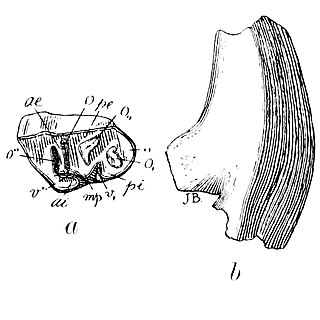Description
This genus is only known from fragments of its maxilla and mandible, and from a few isolated teeth. The teeth were low-crowned (brachydont). The lower molars had an underdeveloped entolophid, a common characteristic with other early Notoungulates, such as Henricosbornia . The first crest, generally present in members of the suborder Typotheria, and the intermediate crest, present in members of the suborder Toxodontia, were absent. Nanolophodon was distinguished from its relatives by the presence of two small crests on the ectoloph, and a large paraconid.

Prosotherium is an extinct genus of hegetotheriid notoungulate. It lived during the Late Oligocene, and its fossilized remains were found in South America.
Lamegoia is an extinct genus of mammals, belonging to the family Didolodontidae. It contains a single species, Lamegoia conodonta, which lived during the Late Paleocene in what is now South America.
Asmithwoodwardia is an extinct genus of mammals, from the order Litopterna. It lived during the Late Paleocene and the Early Eocene, and its fossilized remains were found in South America.
Henricosbornia is an extinct genus of henricosborniid notoungulate that lived from the Late Paleocene to the Middle Eocene of what is now Argentina and Brazil.
Ethegotherium is an extinct genus of Notoungulates, belonging to the suborder Typotheria. It lived from the Lower to the Middle Miocene, and its fossilized remains were discovered in South America. It might be a synonym of the genus Prohegetotherium.
Eohyrax is an extinct genus of Notoungulate, belonging to the suborder Typotheria. It lived during the Middle Eocene, and its remains were discovered in South America.
Transpithecus is an extinct genus of Notoungulates, belonging to the suborder Typotheria. It lived during the Middle Eocene in what is today South America.

Argyrohippus is an extinct genus of notoungulate, belonging to the family Notohippidae. It lived from the Late Oligocene to the Early Miocene, and its fossilized remains were found in South America.

Pseudotypotherium is an extinct genus of Notoungulates, belonging to the suborder Typotheria. It lived from the Late Miocene to the Late Pliocene, and its fossilized remains were discovered in South America.
Ignigena is an extinct genus of notoungulate belonging to the family Interatheriidae. The only known species of this genus is Ignigena minisculus. The genus name means born from the fire, referencing the volcanic deposits in which its fossils were found, while the type species name minisculus means "minuscule", referencing the small size of the animal. It was related to Johnbell. I. minisculus was a small animal with elongated teeth. Its fossilized remains were found in Chile, in deposited dating to the Early Eocene.

Plesiotypotherium is an extinct genus of Notoungulate, belonging to the suborder Typotheria. It lived from the Middle to the Late Miocene, and its fossilized remains were discovered in South America.
Archaeopithecus is an extinct genus of Notoungulate, belonging to the suborder Typotheria. It lived during the Middle Eocene, in what is today Argentina.
Colbertia is an extinct genus of oldfieldthomasiid notoungulate. It lived from the Early to the Middle Eocene, and its fossilized remains were discovered in Argentina and Brazil.
Dolichostylodon is an extinct species of mammal, belonging to the order Notoungulata. It lived during the Middle Eocene, and its fossilized remains were discovered in South America.
Oldfieldthomasia is an extinct genus of Notoungulate, probably related to the suborder Typotheria. It lived during the Middle Eocene, in what is today South America.
Ultrapithecus is an extinct genus of oldfieldthomasiid notoungulate that lived during the Middle Eocene of what is now Argentina.
Altitypotherium is an extinct genus of Notoungulate, belonging to the suborder Typotheria. It lived during the Early Miocene, and its fossilized remains were discovered in South America.

Notopithecus is an extinct genus of Notoungulate, belonging to the suborder Typotheria. It lived from the Middle to the Late Eocene and its fossilized remains were discovered in South America.
Hegetotheriopsis is an extinct genus of hegetotheriid notoungulate. It lived from the Late Oligocene to the Early Miocene, and its fossilized remains are found in Argentina.
Sallatherium is an extinct genus of Notoungulate, belonging to the suborder Typotheria. It lived during the Late Oligocene, and its fossilized remains were discovered in South America.
This page is based on this
Wikipedia article Text is available under the
CC BY-SA 4.0 license; additional terms may apply.
Images, videos and audio are available under their respective licenses.













